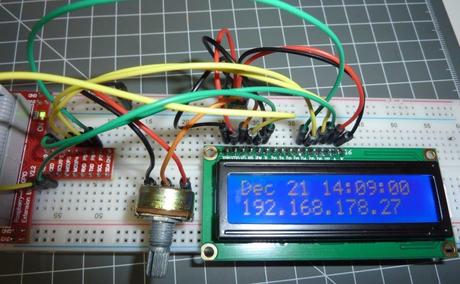In meinem Hardware-Fundus hatte ich noch ein 16×2 Zeichen LCD Display wiederentdeckt, das wollte ich schon länger mal am Raspberry Pi testen und in Betrieb nehmen. Was liegt da näher, um für einen Funktionstest, die aktuelle Uhrzeit und die IP-Adresse meines Mini-Rechners auf dem Display auszugeben. In diesem kleinen Raspberry Pi Projekt zeige ich euch wie ihr ein 16×2 Zeichen LCD an den RasPi anschließt und via Python Script ansteuert.
Material
Folgendes Material habe ich verwendet
- QC1602a 16×2 Zeichen LCD Display
- Drehpotentiometer 50k Ohm
- Breadboard
- Steckbrettkabel Male-Male
- GPIO Breakout
Falls ihr noch kein Breadboard und Kabel besitzt, das Ganze gibt es auch als Set inkl LCD und Poti.
Verkabelung des LCD Display
Die Verkabelung des Display scheint auf den ersten Blick recht komplex, habt ihr allerdings die die Funktion einmal verstanden ist das Setup recht einfach.

Das LCD-Display hat 16 Pins. In der unten stehenden Tabelle habe ich die Verkabelung des Display dargestellt. Da ich, wie ihr auf den Bild erkennen könnt, ein GPIO Breakout verwende habe ich in der letzten Spalte die Verkabelung mit meinem Breakout dokumentiert.
Falls ihr das Display über ein anderes Breakout oder direkt am RasPi bzw. via Breadboard verkabeln wollt habe ich die RasPi GPIO Pins aufgeführt, wie immer ist es die Nummer des Pins auf der Leiste P1. Falls ihr euch unsicher bei der Zuordnung der Pins seit könnt ihr einen Blick auf mein GPIO Pin Worksheet werfen dort die Verbindungen eintragen.
LCD Pin LCD Funktion RasPi Funktion RasPi GPIO-Pin Mein Breakout (T-Cobbler)
01 GND GND GPIO Pin 6 GND
02 +5V +5V GPIO Pin 2 5V0
03 Contrast GND GPIO Pin 6 Potentiometer (mittlerer Pin)
04 RS GPIO7 GPIO Pin 26 CE1
05 RW GND GPIO Pin 6 GND
06 E GPIO8 GPIO Pin 24 CE0
07 Data 0
08 Data 1
09 Data 2
10 Data 3
11 Data 4 GPIO25 GPIO Pin 22 GPIO6
12 Data 5 GPIO24 GPIO Pin 18 GPIO5
13 Data 6 GPIO23 GPIO Pin 16 GPIO4
14 Data 7 GPIO18 GPIO Pin 12 GPIO1
15 +5V GPIO Pin 2 5V0
16 GND GPIO Pin 6 GND
Alternativ gibt es auf der Adafruit Seite ein passendes Verkabelungsdiagramm, allerdings verwenden die wieder eine anderes Breakout.
LCD Display am Raspberry Pi einrichten
Wir steuern das LCD Display via Python an, daher installieren wir als erstes die notwendigen Python Programme und Abhängigkeiten nachdem wir unser System aktualisiert via apt aktualisiert haben.
sudo apt-get -y update & sudo apt-get -y upgrade sudo apt-get install -y python-dev python-setuptools python-pip git sudo easy_install -U distribute sudo pip install rpi.gpio
Dann können wir direkt loslegen, das Python Script, welches ich vorbereitet haben laden wir uns via wget ins Home und machen es via chmod ausführbar.
cd ~ wget -O raspberry.tips.lcd.py http://cdn.raspberry.tips/2014/12/raspberry.tips_.lcd_.py_.txt chmod +x raspberry.tips.lcd.py
Zum Testen eures LCD-Display können wir das Script nun direkt ausführen und uns die Ausgabe auf dem Display ansehen.
sudo python raspberry.tips.lcd.py
Eventuell müsst ihr noch über den Drehpoti den Kontrast eures LCDs einstellen, erhaltet ihr keine oder eine falsche Ausgabe liegt dies vermutlich an der falschen Verkabelung. Falls die angezeigte Uhrzeit nicht stimmt müsst ihr eure Zeitzone via Raspi-config auf die Deutsche (GMT +1) umstellen.
Wer möchte kann mit den unten aufgeführten Script die Ausgabe nach jedem Neustart des RasPi aktivieren. Hierzu müsst ihr den Code in die Datei /etc/init.d/lcd kopieren und dann folgende Befehle ausführen um /etc/init.d/lcd zum automatischen Start hinzuzufügen.
sudo chmod +x /etc/init.d/lcd sudo update-rcd lcd defaults
LCD Python Code
#!/usr/bin/python
# based on code from lrvick, LiquidCrystal and Adafruit
from time import sleep
class Adafruit_CharLCD(object):
# commands
LCD_CLEARDISPLAY = 0x01
LCD_RETURNHOME = 0x02
LCD_ENTRYMODESET = 0x04
LCD_DISPLAYCONTROL = 0x08
LCD_CURSORSHIFT = 0x10
LCD_FUNCTIONSET = 0x20
LCD_SETCGRAMADDR = 0x40
LCD_SETDDRAMADDR = 0x80
# flags for display entry mode
LCD_ENTRYRIGHT = 0x00
LCD_ENTRYLEFT = 0x02
LCD_ENTRYSHIFTINCREMENT = 0x01
LCD_ENTRYSHIFTDECREMENT = 0x00
# flags for display on/off control
LCD_DISPLAYON = 0x04
LCD_DISPLAYOFF = 0x00
LCD_CURSORON = 0x02
LCD_CURSOROFF = 0x00
LCD_BLINKON = 0x01
LCD_BLINKOFF = 0x00
# flags for display/cursor shift
LCD_DISPLAYMOVE = 0x08
LCD_CURSORMOVE = 0x00
# flags for display/cursor shift
LCD_DISPLAYMOVE = 0x08
LCD_CURSORMOVE = 0x00
LCD_MOVERIGHT = 0x04
LCD_MOVELEFT = 0x00
# flags for function set
LCD_8BITMODE = 0x10
LCD_4BITMODE = 0x00
LCD_2LINE = 0x08
LCD_1LINE = 0x00
LCD_5x10DOTS = 0x04
LCD_5x8DOTS = 0x00
def __init__(self, pin_rs=7, pin_e=8, pins_db=[25, 24, 23, 18], GPIO=None):
# Emulate the old behavior of using RPi.GPIO if we haven't been given
# an explicit GPIO interface to use
if not GPIO:
import RPi.GPIO as GPIO
GPIO.setwarnings(False)
self.GPIO = GPIO
self.pin_rs = pin_rs
self.pin_e = pin_e
self.pins_db = pins_db
self.GPIO.setmode(GPIO.BCM)
self.GPIO.setup(self.pin_e, GPIO.OUT)
self.GPIO.setup(self.pin_rs, GPIO.OUT)
for pin in self.pins_db:
self.GPIO.setup(pin, GPIO.OUT)
self.write4bits(0x33) # initialization
self.write4bits(0x32) # initialization
self.write4bits(0x28) # 2 line 5x7 matrix
self.write4bits(0x0C) # turn cursor off 0x0E to enable cursor
self.write4bits(0x06) # shift cursor right
self.displaycontrol = self.LCD_DISPLAYON | self.LCD_CURSOROFF | self.LCD_BLINKOFF
self.displayfunction = self.LCD_4BITMODE | self.LCD_1LINE | self.LCD_5x8DOTS
self.displayfunction |= self.LCD_2LINE
# Initialize to default text direction (for romance languages)
self.displaymode = self.LCD_ENTRYLEFT | self.LCD_ENTRYSHIFTDECREMENT
self.write4bits(self.LCD_ENTRYMODESET | self.displaymode) # set the entry mode
self.clear()
def begin(self, cols, lines):
if (lines > 1):
self.numlines = lines
self.displayfunction |= self.LCD_2LINE
def home(self):
self.write4bits(self.LCD_RETURNHOME) # set cursor position to zero
self.delayMicroseconds(3000) # this command takes a long time!
def clear(self):
self.write4bits(self.LCD_CLEARDISPLAY) # command to clear display
self.delayMicroseconds(3000) # 3000 microsecond sleep, clearing the display takes a long time
def setCursor(self, col, row):
self.row_offsets = [0x00, 0x40, 0x14, 0x54]
if row > self.numlines:
row = self.numlines - 1 # we count rows starting w/0
self.write4bits(self.LCD_SETDDRAMADDR | (col + self.row_offsets[row]))
def noDisplay(self):
""" Turn the display off (quickly) """
self.displaycontrol &= ~self.LCD_DISPLAYON
self.write4bits(self.LCD_DISPLAYCONTROL | self.displaycontrol)
def display(self):
""" Turn the display on (quickly) """
self.displaycontrol |= self.LCD_DISPLAYON
self.write4bits(self.LCD_DISPLAYCONTROL | self.displaycontrol)
def noCursor(self):
""" Turns the underline cursor off """
self.displaycontrol &= ~self.LCD_CURSORON
self.write4bits(self.LCD_DISPLAYCONTROL | self.displaycontrol)
def cursor(self):
""" Turns the underline cursor on """
self.displaycontrol |= self.LCD_CURSORON
self.write4bits(self.LCD_DISPLAYCONTROL | self.displaycontrol)
def noBlink(self):
""" Turn the blinking cursor off """
self.displaycontrol &= ~self.LCD_BLINKON
self.write4bits(self.LCD_DISPLAYCONTROL | self.displaycontrol)
def blink(self):
""" Turn the blinking cursor on """
self.displaycontrol |= self.LCD_BLINKON
self.write4bits(self.LCD_DISPLAYCONTROL | self.displaycontrol)
def DisplayLeft(self):
""" These commands scroll the display without changing the RAM """
self.write4bits(self.LCD_CURSORSHIFT | self.LCD_DISPLAYMOVE | self.LCD_MOVELEFT)
def scrollDisplayRight(self):
""" These commands scroll the display without changing the RAM """
self.write4bits(self.LCD_CURSORSHIFT | self.LCD_DISPLAYMOVE | self.LCD_MOVERIGHT)
def leftToRight(self):
""" This is for text that flows Left to Right """
self.displaymode |= self.LCD_ENTRYLEFT
self.write4bits(self.LCD_ENTRYMODESET | self.displaymode)
def rightToLeft(self):
""" This is for text that flows Right to Left """
self.displaymode &= ~self.LCD_ENTRYLEFT
self.write4bits(self.LCD_ENTRYMODESET | self.displaymode)
def autoscroll(self):
""" This will 'right justify' text from the cursor """
self.displaymode |= self.LCD_ENTRYSHIFTINCREMENT
self.write4bits(self.LCD_ENTRYMODESET | self.displaymode)
def noAutoscroll(self):
""" This will 'left justify' text from the cursor """
self.displaymode &= ~self.LCD_ENTRYSHIFTINCREMENT
self.write4bits(self.LCD_ENTRYMODESET | self.displaymode)
def write4bits(self, bits, char_mode=False):
""" Send command to LCD """
self.delayMicroseconds(1000) # 1000 microsecond sleep
bits = bin(bits)[2:].zfill(8)
self.GPIO.output(self.pin_rs, char_mode)
for pin in self.pins_db:
self.GPIO.output(pin, False)
for i in range(4):
if bits[i] == "1":
self.GPIO.output(self.pins_db[::-1][i], True)
self.pulseEnable()
for pin in self.pins_db:
self.GPIO.output(pin, False)
for i in range(4, 8):
if bits[i] == "1":
self.GPIO.output(self.pins_db[::-1][i-4], True)
self.pulseEnable()
def delayMicroseconds(self, microseconds):
seconds = microseconds / float(1000000) # divide microseconds by 1 million for seconds
sleep(seconds)
def pulseEnable(self):
self.GPIO.output(self.pin_e, False)
self.delayMicroseconds(1) # 1 microsecond pause - enable pulse must be > 450ns
self.GPIO.output(self.pin_e, True)
self.delayMicroseconds(1) # 1 microsecond pause - enable pulse must be > 450ns
self.GPIO.output(self.pin_e, False)
self.delayMicroseconds(1) # commands need > 37us to settle
def message(self, text):
""" Send string to LCD. Newline wraps to second line"""
for char in text:
if char == '\n':
self.write4bits(0xC0) # next line
else:
self.write4bits(ord(char), True)
if __name__ == '__main__':
lcd = Adafruit_CharLCD()
cmd = "ip addr show eth0 | grep inet | awk '{print $2}' | cut -d/ -f1"
lcd.begin(16, 1)
def run_cmd(cmd):
p = Popen(cmd, shell=True, stdout=PIPE)
output = p.communicate()[0]
return output
while 1:
lcd.clear()
ipaddr = run_cmd(cmd)
lcd.message(datetime.now().strftime('%b %d %H:%M:%S\n'))
lcd.message('IP %s' % (ipaddr))
sleep(2)
Autostart Script
### BEGIN INIT INFO
# Provides: LCD - date / time / ip address
# Required-Start: $remote_fs $syslog
# Required-Stop: $remote_fs $syslog
# Default-Start: 2 3 4 5
# Default-Stop: 0 1 6
# Short-Description: Liquid Crystal Display
# Description: date / time / ip address
### END INIT INFO
#! /bin/sh
# /etc/init.d/lcd
export HOME
case "$1" in
start)
echo "Starting LCD"
/home/pi/raspberry.tips.lcd.py 2>&1 &
;;
stop)
echo "Stopping LCD"
LCD_PID=`ps auxwww | grep raspberry.tips.lcd.py | head -1 | awk '{print $2}'`
kill -9 $LCD_PID
;;
*)
echo "Usage: /etc/init.d/lcd {start|stop}"
exit 1
;;
esac
exit 0

